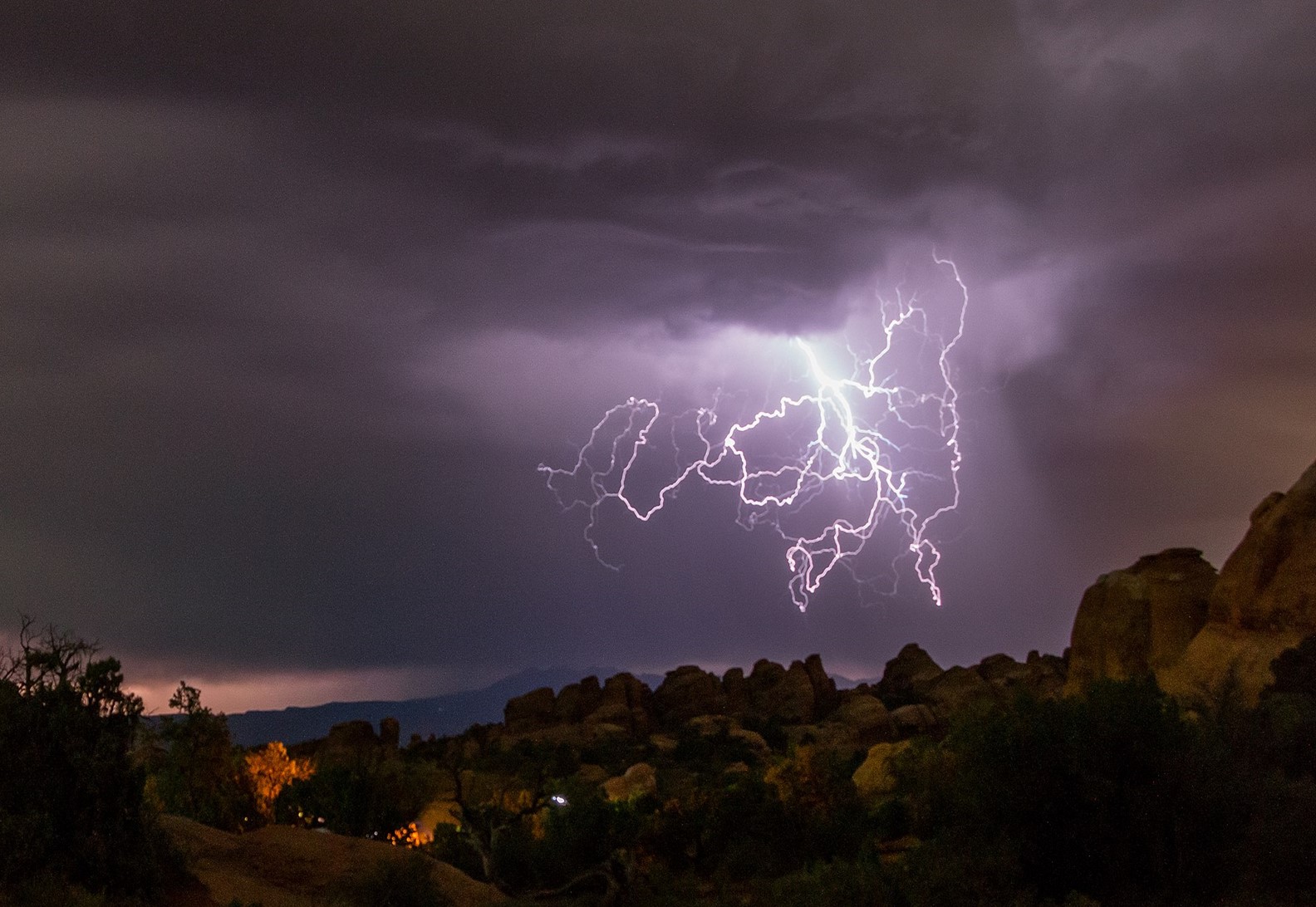
Credit: Jorn van Maanen from Netherlands, via Wikimedia Commons
We’ve talked before about how lightning breaks nitrogen molecules into nitric oxide—which falls to Earth in rainwater and nourishes plants.
But we now know that lightning storms have another essential function.
After forming nitric oxide, a secondary reaction makes oxidants, which clean the atmosphere.
Oxidants are essentially water molecules that lost a hydrogen atom. To replace it, they react with other compounds, including methane and CO2.
They oxidize these into other forms that also fall to Earth in rain, thereby reducing greenhouse gases in the atmosphere.
The volume of oxidants was thought to be tiny—a few parts per trillion.
Until, in 2012, some brave atmospheric scientists flew their research plane directly into electrical storms in Texas and Oklahoma. They were stunned to find oxidant levels thousands of times higher even though no lightning was present.
Eventually, they figured out that invisible electrical discharges in the top of a thunderhead, before lightning is formed, produce huge volumes of oxidants directly—without first forming nitric oxide.
Their new estimates suggest that electrical storms could produce a sixth of our atmosphere’s cleansing oxidants.
Studies suggest that, if Earth continues to warm, we’ll have more lightning, which could increase atmospheric oxidants and help counter rising greenhouse gas levels.
Background
Synopsis: In 2012, storm chaser scientists flew a NASA research plane through several lightning storms to learn about chemical reactions that occur when lightning courses through the atmosphere. They were shocked to find out that as electrical charges build up in thunderheads, even before lightning bolts crackle through the sky, electrical discharges dissociate water vapor and ozone to generate huge concentrations of atmospheric cleansing oxidants—thousands of times more than ever before recorded. These reactive oxidants dismember greenhouse gases like methane, producing less harmful compounds that rain out of the atmosphere to become trapped on Earth’s surface. This newfound silver lining could contribute up to one-sixth of the cleaning power of Earth’s atmosphere, just as a warming climate progressively intensifies global lightning.
- We talked about how lightning forms in a previous episode (ED-027 Lightning Strikes).
- Around 1,800 thunderstorms occur every day, producing 40 lightning strikes per second. The electrified Earth sees about 1.4 billion lightning strikes per year.
- As freezing water droplets fall through a cloud, they carry negative electrical charges with them to the bottom of the cloud.
- Electrical charges build up in different parts of the cloud until lightning finally discharges, connecting negatively charged parts of the cloud to positively charged areas in clouds or on the ground to neutralize charge imbalances.
- Lightning bolts are about an inch (2.5 cm) wide and travel at about 200,000 mi (322,000 km) per hour.
- Lightning heats the air around it about as hot as the sun’s surface, and the expanding air causes a shock wave we call thunder.
- Most lightning travels from cloud to cloud and never hits the ground.
- Scientists have long studied the atmospheric chemistry of thunderstorms that start with ingredients of atmospheric nitrogen, oxygen and water vapor.
- When lightning surges through the atmosphere it breaks strongly bonded nitrogen molecules (N2) apart, allowing them to combine with oxygen to produce water soluble nitric oxide (NO) which rains onto the Earth’s surface.

Raindrops on a flower bud reflect nearby open yellow flowers. Nitrogen is an important plant nutrient delivered by raindrops.
Credit: Brocken Inaglory, via Wikimedia Commons - Then, secondary reactions with water vapor (H2O) produce reactive oxidants like hydroxyl (OH) and hydroperoxyl (HO2) along with other chemical species.
- When lightning surges through the atmosphere it breaks strongly bonded nitrogen molecules (N2) apart, allowing them to combine with oxygen to produce water soluble nitric oxide (NO) which rains onto the Earth’s surface.
- Hydroxyl has been called the “detergent of the atmosphere” because it initiates many chemical reactions and can oxidize just about any chemical in the troposphere where Earth’s weather occurs.
- Hydroxyl (OH) is basically a water molecule that has lost one of its hydrogen atoms, so it is very reactive since it needs to replace its lost hydrogen atom to balance its charge. Hydroperoxyl (HO2) is similarly reactive.
- These oxidants react with methane (CH4) and carbon monoxide (CO) to produce less harmful compounds through oxidation.
- Some of the resulting compounds are sticky and attach themselves to airborne particles while other compounds are water soluble, so the products of these cleansing reactions ultimately end up falling to Earth within raindrops.
- The volume of these cleansing oxidants in Earth’s atmosphere are incredibly tiny. The most OH ever seen in the atmosphere was a few parts per trillion, and the maximum HO2 was around 150 parts per trillion.
- Studies of lightning had historically focused on what it does near the ground, but researchers had never directly observed the reactions that form lightning bolts from inside a thunderhead.
- So, in May and June of 2012, several brave atmospheric chemists and lightning scientists hopped aboard NASA’s airborne DC-8 science laboratory and headed into storm clouds in Texas, Oklahoma and Colorado.

NASA’s DC-8 flying science laboratory circles NASA's Armstrong Flight Research Center in Palmdale, California.
Credit: NASA - Generally, even storm chasing planes avoid the cores of thunderstorms because they can be dangerously unpredictable, but they can fly through the characteristic “anvil” area where winds spread the cloud outward at the top of the thunderhead.
- So, in May and June of 2012, several brave atmospheric chemists and lightning scientists hopped aboard NASA’s airborne DC-8 science laboratory and headed into storm clouds in Texas, Oklahoma and Colorado.
- Visible lightning typically occurs in the part of the anvil closest to the core of the thunderstorm, but subvisible electrical discharges pulse throughout the anvil.
- Weaker subvisible charges require special instruments to detect because they can’t be seen by the naked eye, but these occur throughout thunderheads as a prelude to lightning.
- As the researchers started collecting background data in the anvil before any lightning was sighted from the plane or ground, they recorded subvisual electrical charges as expected but were stunned that the concentration of hydroxyl and hydroperoxyl radicals was off the charts—thousands of times the highest readings ever recorded.
- Conventional wisdom said that atmospheric hydroxyl and hydroperoxyl form in secondary reactions that require nitric oxide as a reactant, but there was no nitric oxide detected. No lightning had occurred nearby to create the NO from N2 yet.
- Scientists had never seen the atmospheric oxidants produced directly (in one step) by electrical discharges. Puzzled, they put the data on the shelf.
- The busy researchers focused on other experiments, but the unusual readings were still on their minds. How did the cleansing oxidants get there in the absence of NO?
- A few years later they looked at the data again and determined that the readings were true—there was no problem with the accuracy of their instruments.
- The scientists did lab experiments that showed that weak electrical discharges could directly create hydroxyls and hydroperoxyls, even if they were subvisible.
- They reanalyzed the data from the 2012 thunder clouds and noted that after each lightning flash (recorded from the plane and on the ground) the concentrations of hydroxyl and hydroperoxyl increased by thousands of parts per trillion.

A classic anvil shaped thunderhead is flattened as winds shear its top.
Credit: Hussein Kefel, via Wikimedia Commons - They determined that subvisible electrical discharges that occur in the anvil and precede initiation of lightning produce the cleansing oxidants directly.
- Lightning bolts also produce these oxidants both directly and indirectly from secondary reactions with nitric oxide.
- Using the concentration of hydroxyl and hydroperoxyl generated in the anvil clouds over Texas, Oklahoma and Colorado, they extrapolated to deduce the volume of oxidants that could be produced from all global thunderstorms at any given time.
- Remember, around 1,800 thunderstorms occur every day producing about 40 lightning strikes per second.
- The researchers attribute 2% to 16% of the production of global atmospheric cleansing oxidants to lightning and the subvisible electrical particles in thunderheads.
- Before these findings, scientists believed the contribution of atmospheric oxidants from lightning was negligible, but these estimates suggest lightning processes like these produce up to a sixth of Earth’s atmospheric oxidation capacity.
- The previously unobserved mechanism of direct atmospheric oxidant production dramatically increases the importance of thunderstorms and lightning in removing greenhouse gases from Earth’s atmosphere.
- However, more studies need to be done in thunder clouds in other regions to determine if the tropical clouds show the same phenomenon as these temperate region clouds.
- Some studies suggest a warming atmosphere with increased water vapor will result in more thunderstorms and lightning, while others suggest that storms and lightning will simply become more intense.
